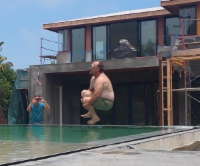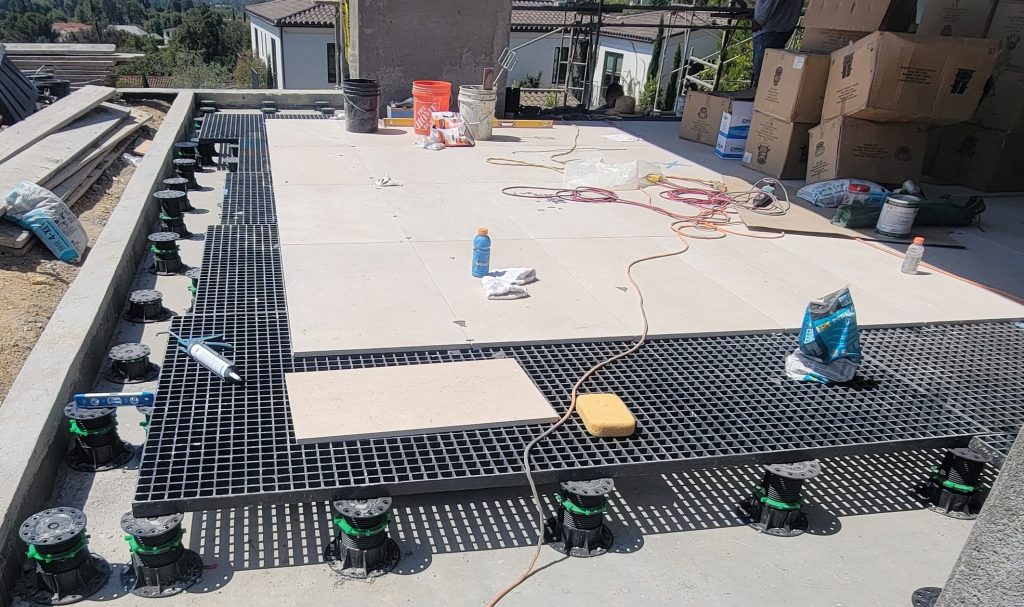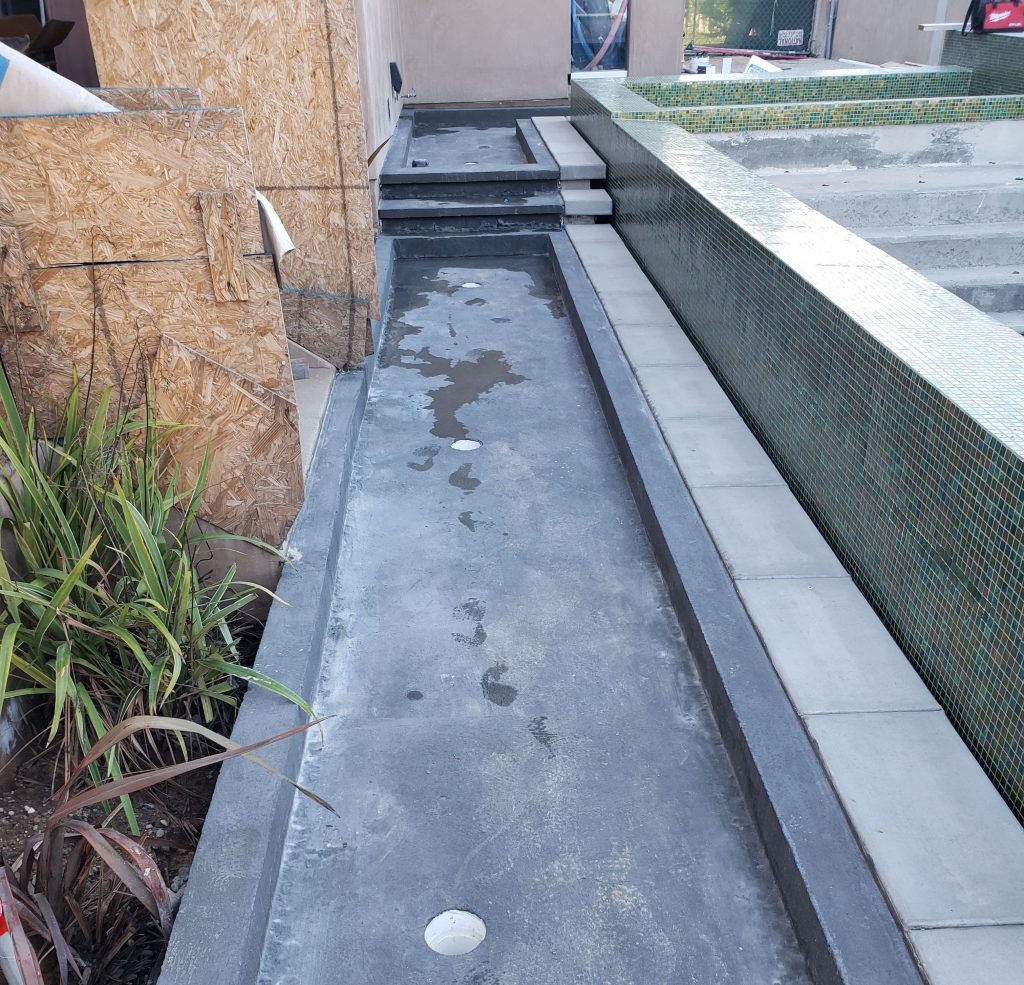Fine Points: Consider the Cannonball


Kevin Cobabe has a profound love of cannonball dives and has a made a habit christening his pools with a patented big splash. But there’s more to the ritual than meets the eye, he says. By considering the cannonball, he designs pools with sudden bather surge in mind.
By Kevin Cobabe
Whenever I approach a new design, I consider a cannonball. I don’t mean the ordinance delivered by an actual cannon, but the familiar party dive so many of us enjoy performing, especially in a swimming pool where the resulting splash shares the joy of getting wet with those near the water’s edge.
I’ve always enjoyed doing cannonball dives and have made them kind of a kinetic personal emblem, an act of brazen joy that fits well my fun-loving attitude, and role as a pool builder. Not only can I build a swimming pool, but when it’s done, I know how to use it. Suffice it say, I have learned to play the cannonball like a Stratovarius. It is both art and soggy mayhem all in one.
But there’s also an extremely practical aspect to my cannonball visualization; one that directly impacts how I choose to engineer and construct pools, particularly edge treatments, and the deck area immediately adjacent to the water’s edge.
THE SPLASH TEST
A cannonball dive sends surface waves surging outward from the point of impact — a massive pebble in a pond, so to speak. The size of the waves is relative to the amount of displacement and velocity of dive impact. When a big guy like me breaks the water’s surface, the impending splash and wave surge will inundate an average-sized residential pool and easily overflow the edges.
How the pool’s edges and surrounding surfaces accommodate such sudden “bather surge” encompasses some important fundamental design considerations. It’s a subject that is both fascinating and critical to proper hydraulic function and consumer experience.
One of the most influential articles I’ve read on the subject was way back in November 2006, in WaterShapes, “Over the Edge” by Steve Gutai. It’s a concise discussion of the fundamentals of water flowing over an edge, or weir. In the case of a sudden surge from a cannonball, the edge of the pool becomes a weir over which the undulating water flows.
The article looks at two primary issues, the importance of calculating estimated bather surge, and the “behavior” of the water as it flows over the edge.

Understanding the hydraulics and physics of water flowing over an edge impacts a variety of design details. When I first read that article, it completely changed the way I looked at vanishing-edge design details. For example, sloping the edge outward over a narrow catch basin can result in water essentially overshooting the basin and jumping up onto the coping.
These days I typically slope the edge inward to keep the flow over the edge tighter to the spillway wall and more likely to hug the surface of the spillway wall. But even more important, I’m sizing the basin on a 1:1 ratio when circumstances allow. That means if I have a two-foot fall from the top of the edge wall to the surface of the catch basin, I’ll design a basin that is two feet wide.
Regardless of the type of edge treatment, be it a vanishing edge, perimeter overflow, gutter system, or traditional coping with skimmers, you have to know how much surge the system will accommodate and how the water moves over the edge and through the plumbing system.
CALCULATING SURGE
Surge capacity in swimming pools refers to the volume of water that can be accommodated in the pool’s system when bathers enter or leave, causing a displacement of water as well as water in transit and precipitation. Properly calculating this capacity is essential for maintaining water quality, ensuring safety, and optimizing the pool’s filtration and circulation systems.
The primary reason for calculating surge capacity is to manage the displacement of water when people enter or exit the pool. We know this. Without adequate surge capacity, water could overflow or strain the filtration system, leading to compromised water quality and potential safety hazards. Additionally, surge capacity helps prevent the pool from losing water unnecessarily, which is essential for maintaining a consistent water level and minimizing operational costs.
Several factors influence the calculation of surge capacity for a swimming pool:
- Pool Size and Shape: The dimensions and volume of the pool directly affect how much water is displaced when people enter it. Larger pools with potentially high bather loads require greater surge capacity.
- Number of Bathers: The number of people using the pool at any given time significantly impacts water displacement. A crowded pool needs a higher surge capacity to accommodate the added volume.
- Bather Weight and Volume: The average weight and body volume of the bathers also play a role in water displacement. Heavier bathers will displace more water, requiring greater surge capacity.
- Deck and Gutter Design: The design of the pool deck, drains and gutter systems influences how efficiently the displaced water is managed. A well-designed system can help recirculate water back into the pool, to some extent mitigating the need for a large surge capacity.
Calculating surge capacity involves several steps, including estimating the volume of water displaced by bathers and determining the required storage to handle that volume of displacement, along with environmental conditions such as evaporative loss and average fall of rainwater. A basic rule of thumb I have often used at the initial design of the mechanical system is calculating two inches of water across the entire surface of the vessel as the capacity you will need for your surge basin. Let’s use a simple 20-by-40-foot perimeter overflow pool as our model. Here’s how you do it:

Let’s start with the basic rules of calculating a cubic foot of water (or 1,728 cubic inches with each one-inch layer of water within the cube being 144 cubic inches) being equal to 7.48 gallons and our pools average depth being five feet to get the total volume of the pool. (20-by-40-by-5) by 7.48 = 29,920 gallons of pool water.
With our 20-by-40-foot pool we have a total surface area of 800 sq. ft. Multiply that by 144 we get 115,200 cubic inches. Divide 115,200 by 1,728 to get a total of 66.7 cubic feet of water. Multiply 66.7-by- 7.48 and we now know the total gallons of one inch of water across the entire surface of the pool is 499 gallons. Multiply by two for two inches of water or surge basin minimum capacity. For this pool we will need a tank or basin sized to hold 1,000 gallons.
Note: We will be teaching this process in a more detailed equation at the IPSE in Dallas in November as part of “Advanced Fluid Engineering 4311”. During the class We take into account not only surface area of the pool but also:
- Our total basin/surge tank interior height (if fully enclosed) or total depth/capacity (if open catch basin).
- Our minimum operating level of the surge tank before vortex occurs at the suction outlets.
- Average evaporative loss for the region.
- Average Annual precipitation.
- Bather load
- Water in transit (water within the pipes, gutter and vessel while in full operation).
- Wave action freeboard
- Overflow pipe elevation within the surge tank or basin
It is very difficult to undersize a surge tank when you account for all of these factors up front.
DECK DRAINS
In many designs, such as the famous “Lautner Edge” slot designs or perimeter over flows into grated gutter systems, and even traditional coping, the deck will need to accommodate water flowing out of the pool. I currently have five projects going, and each has either a perimeter overflow, or a combination of vanishing edge with Lautner edge on one side.
In all cases, despite differences in details, the design must accommodate the bather surge. With deck design, generally you’re sloping away from your pool, but there are certain situations where we’ll slope the coping inward if it’s covering a gutter system or something like that, so it helps to contain some of that splash at least, and you’re not losing everything down deck drains.
As a rule, we pitch decks 1/8th-inch per foot, directing water to either deck drains or a grated gutter. Again, by knowing the surge volume, you can design drain systems with adequate plumbing sizes, so that even in case of a multiple cannonballs, the system doesn’t back up and flood the deck.
Also, in considering the cannonball, I’m taking into account how the water will impact surrounding features, such as planting beds. In some situations, I’ve built small curbs around planted areas to prevent flooding from the occasional cannonball.
In many cases these days, people are turning to raise decking pavers on pedestal systems. The idea is water flows between the pavers and into the space below, which functions as a kind of massive catch basin. In recent years, raised decks have become extremely popular because you don’t see any drains anywhere, and they can be completely flat with no need to worry about sloping the surface.
All the water goes through the ungrouted joints of paver to underneath the deck and is directed to whatever drainage needs you require for the given area. We have installed multiple types of drainage un pedestals and pavers. Drains closer to the pool edge will sometime direct the splash water back to the surge tank. Some projects require that you recycle rain water and use underground cisterns to hold it while other just use the drainage to direct it to the nearest storm drain or exterior gutter to the property
The bottom line is that by understanding the factors that influence water displacement — and following a systematic approach to calculate the required surge capacity — pool designers and builders can ensure that their pools are equipped to handle varying bather loads without compromising water quality or safety.
Kevin Cobabe is president of Dynamic Pool & Spa Construction, a high-end watershaping firm based in Redondo Beach, CA. He is also a founding member of the International Watershape Institute (IWI), faculty member for Watershape University and a regular contributor to watershapes.com and the Ask the Masters Facebook group. He is also a master GRAVY sommelier.










